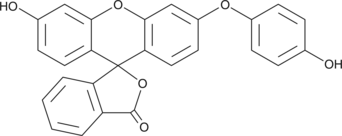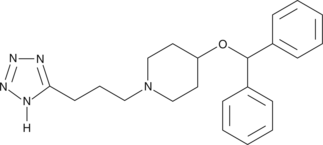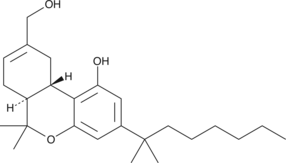Chemicals
Showing 22051–22200 of 41137 results
-
Hoechst 33342 is a cell-permeable, benzimidazole dye that stains DNA by binding to the minor groove of adenine and thymine-rich sequences.{22804} It emits blue fluorescence (excitation 350 nm/emission maximum 461 nm) when bound to double stranded DNA and is useful as a marker of nuclei for cell cycle studies and to distinguish nuclear morphology in apoptotic cells.{22204,256047,25603}
Brand:CaymanSKU:-Hoechst 33342 is a cell-permeable, benzimidazole dye that stains DNA by binding to the minor groove of adenine and thymine-rich sequences.{22804} It emits blue fluorescence (excitation 350 nm/emission maximum 461 nm) when bound to double stranded DNA and is useful as a marker of nuclei for cell cycle studies and to distinguish nuclear morphology in apoptotic cells.{22204,256047,25603}
Brand:CaymanSKU:-Homarylamine (hydrochloride) (Item No. 21351) is an analytical reference standard that is structurally categorized as a phenethylamine. The physiological and toxicological properties of this compound are not known. This product is intended for research and forensic applications.
Brand:CaymanSKU:21351 -Out of stock
Homarylamine (hydrochloride) (Item No. 21351) is an analytical reference standard that is structurally categorized as a phenethylamine. The physiological and toxicological properties of this compound are not known. This product is intended for research and forensic applications.
Brand:CaymanSKU:21351 -Out of stock
Homatropine is an anticholinergic agent.{55132,55130} It reduces acetylcholine-induced contractions of isolated goat detrusor muscle strips when used at a concentration of 5 µM.{55132} Homatropine (1 µM) inhibits acetylcholine- or methacholine-induced contraction of isolated rat anococcygeus muscle.{55130} It inhibits serotonin- or thrombin-induced platelet aggregation in isolated sheep platelet-rich plasma (IC50s = 4.3 and 100 µM, respectively).{55131} Topical ophthalmic administration of homatropine induces partial mydriasis in Angora goats.{55133}
Brand:CaymanSKU:30359 - 1 gAvailable on backorder
Homodestcardin is a cyclic depsipeptide fungal metabolite that has been found in T. roseum and has immunosuppressant activity.{48980} It inhibits concanavalin A-induced proliferation of isolated mouse T cells (IC50 = 0.86 µM).
Brand:CaymanSKU:30052 - 1 mgAvailable on backorder
Homogentisic acid is a phenolic acid and intermediate in the catabolism of aromatic amino acids, including phenylalanine and tyrosine. It is formed in excess during alkaptonuria, whereas excess deposition of homogentisic acid in connective tissues produces ochronosis.{31989}
Brand:CaymanSKU:20045 -Available on backorder
Homogentisic acid is a phenolic acid and intermediate in the catabolism of aromatic amino acids, including phenylalanine and tyrosine. It is formed in excess during alkaptonuria, whereas excess deposition of homogentisic acid in connective tissues produces ochronosis.{31989}
Brand:CaymanSKU:20045 -Available on backorder
Homogentisic acid is a phenolic acid and intermediate in the catabolism of aromatic amino acids, including phenylalanine and tyrosine. It is formed in excess during alkaptonuria, whereas excess deposition of homogentisic acid in connective tissues produces ochronosis.{31989}
Brand:CaymanSKU:20045 -Available on backorder
Homogentisic acid is a phenolic acid and intermediate in the catabolism of aromatic amino acids, including phenylalanine and tyrosine. It is formed in excess during alkaptonuria, whereas excess deposition of homogentisic acid in connective tissues produces ochronosis.{31989}
Brand:CaymanSKU:20045 -Available on backorder
Homoharringtonine is an alkaloid originally isolated from C. harringtonia and a homolog of harringtonine (Item No. 15361) that has diverse biological activities including protein synthesis inhibitory, antiviral, antiparasitic, and anticancer properties.{42189} Homoharringtonine inhibits the chain elongation phase of translation in eukaryotes.{42190} It inhibits diphenylalanine formation by rabbit reticulocyte and human placental ribosomes in cell-free assays and binds to human 80S ribosomes (Kd = 39 nM). Homoharringtonine is active against coronaviruses, reducing the viral load in vitro and in vivo and prevents severe symptoms in porcine and chicken models of porcine epidemic diarrhea virus (PEDV) and Newcastle disease virus (NDV), respectively.{53654} It reduces the infectious virus yield and viral RNA copy numbers in the culture supernatant of Vero E6 cells infected with severe acute respiratory syndrome coronavirus 2 (SARS-CoV-2) (EC50s = 2.55 and 2.14 µM, respectively).{53655} It also inhibits the growth of P. falciparum in cultured in human erythrocytes (IC50 = 4 nM).{42191} Homoharringtonine is cytotoxic and inhibits the proliferation of Jurkat acute T cell leukemia (IC50 = 9 nM) and K562 chronic myelogenous leukemia (CML) cells (IC50 = 408 μg/ml).{42192,42193} In vivo, it decreases the number of peripheral leukemia stem cells and increases survival in CML and B cell acute lymphoblastic leukemia (B-ALL) mouse models when administered at a dose of 0.5 mg/kg.{42194} Formulations containing homoharringtonine have been used in the treatment of CML in patients with resistance and/or intolerance to two or more tyrosine kinase inhibitors.
Brand:CaymanSKU:-Homoharringtonine is an alkaloid originally isolated from C. harringtonia and a homolog of harringtonine (Item No. 15361) that has diverse biological activities including protein synthesis inhibitory, antiviral, antiparasitic, and anticancer properties.{42189} Homoharringtonine inhibits the chain elongation phase of translation in eukaryotes.{42190} It inhibits diphenylalanine formation by rabbit reticulocyte and human placental ribosomes in cell-free assays and binds to human 80S ribosomes (Kd = 39 nM). Homoharringtonine is active against coronaviruses, reducing the viral load in vitro and in vivo and prevents severe symptoms in porcine and chicken models of porcine epidemic diarrhea virus (PEDV) and Newcastle disease virus (NDV), respectively.{53654} It reduces the infectious virus yield and viral RNA copy numbers in the culture supernatant of Vero E6 cells infected with severe acute respiratory syndrome coronavirus 2 (SARS-CoV-2) (EC50s = 2.55 and 2.14 µM, respectively).{53655} It also inhibits the growth of P. falciparum in cultured in human erythrocytes (IC50 = 4 nM).{42191} Homoharringtonine is cytotoxic and inhibits the proliferation of Jurkat acute T cell leukemia (IC50 = 9 nM) and K562 chronic myelogenous leukemia (CML) cells (IC50 = 408 μg/ml).{42192,42193} In vivo, it decreases the number of peripheral leukemia stem cells and increases survival in CML and B cell acute lymphoblastic leukemia (B-ALL) mouse models when administered at a dose of 0.5 mg/kg.{42194} Formulations containing homoharringtonine have been used in the treatment of CML in patients with resistance and/or intolerance to two or more tyrosine kinase inhibitors.
Brand:CaymanSKU:-Homoharringtonine is an alkaloid originally isolated from C. harringtonia and a homolog of harringtonine (Item No. 15361) that has diverse biological activities including protein synthesis inhibitory, antiviral, antiparasitic, and anticancer properties.{42189} Homoharringtonine inhibits the chain elongation phase of translation in eukaryotes.{42190} It inhibits diphenylalanine formation by rabbit reticulocyte and human placental ribosomes in cell-free assays and binds to human 80S ribosomes (Kd = 39 nM). Homoharringtonine is active against coronaviruses, reducing the viral load in vitro and in vivo and prevents severe symptoms in porcine and chicken models of porcine epidemic diarrhea virus (PEDV) and Newcastle disease virus (NDV), respectively.{53654} It reduces the infectious virus yield and viral RNA copy numbers in the culture supernatant of Vero E6 cells infected with severe acute respiratory syndrome coronavirus 2 (SARS-CoV-2) (EC50s = 2.55 and 2.14 µM, respectively).{53655} It also inhibits the growth of P. falciparum in cultured in human erythrocytes (IC50 = 4 nM).{42191} Homoharringtonine is cytotoxic and inhibits the proliferation of Jurkat acute T cell leukemia (IC50 = 9 nM) and K562 chronic myelogenous leukemia (CML) cells (IC50 = 408 μg/ml).{42192,42193} In vivo, it decreases the number of peripheral leukemia stem cells and increases survival in CML and B cell acute lymphoblastic leukemia (B-ALL) mouse models when administered at a dose of 0.5 mg/kg.{42194} Formulations containing homoharringtonine have been used in the treatment of CML in patients with resistance and/or intolerance to two or more tyrosine kinase inhibitors.
Brand:CaymanSKU:-Homoplantaginin is a flavonoid glycoside that has been found in S. plebeia and has antioxidant and anti-inflammatory activities.{46804,46805,46806} It scavenges 2,2-diphenyl-1-picrylhydrazyl (DPPH; Item No. 14805) radicals with an IC50 value of 0.35 µg/ml in a cell-free assay.{46805} Homoplantaginin reverses hydrogen peroxide-induced decreases in glutathione (GSH) levels and glutathione peroxidase (GPX) and superoxide dismutase (SOD) activity in HL-7702 cells when used at concentrations ranging from 1 to 100 µg/ml. It reduces protein levels of toll-like receptor 4 (TLR4), MyD88, caspase-1, and IL-1β induced by palmitic acid (Item No. 10006627) in human umbilical vein endothelial cells (HUVECs) when used at concentrations of 1 and 10 µM.{46806} Homoplantaginin (50 and 100 mg/kg) decreases serum alanine aminotransferase (ALT), aspartate aminotransferase (AST), TNF-α, and IL-1 levels, as well as reduces liver inflammatory cell infiltration and hepatocyte necrosis in a mouse model of immunological liver injury induced by Bacillus Calmette-Guérin (BCG) vaccine and LPS.{46805}
Brand:CaymanSKU:29853 - 10 mgAvailable on backorder
Homoplantaginin is a flavonoid glycoside that has been found in S. plebeia and has antioxidant and anti-inflammatory activities.{46804,46805,46806} It scavenges 2,2-diphenyl-1-picrylhydrazyl (DPPH; Item No. 14805) radicals with an IC50 value of 0.35 µg/ml in a cell-free assay.{46805} Homoplantaginin reverses hydrogen peroxide-induced decreases in glutathione (GSH) levels and glutathione peroxidase (GPX) and superoxide dismutase (SOD) activity in HL-7702 cells when used at concentrations ranging from 1 to 100 µg/ml. It reduces protein levels of toll-like receptor 4 (TLR4), MyD88, caspase-1, and IL-1β induced by palmitic acid (Item No. 10006627) in human umbilical vein endothelial cells (HUVECs) when used at concentrations of 1 and 10 µM.{46806} Homoplantaginin (50 and 100 mg/kg) decreases serum alanine aminotransferase (ALT), aspartate aminotransferase (AST), TNF-α, and IL-1 levels, as well as reduces liver inflammatory cell infiltration and hepatocyte necrosis in a mouse model of immunological liver injury induced by Bacillus Calmette-Guérin (BCG) vaccine and LPS.{46805}
Brand:CaymanSKU:29853 - 25 mgAvailable on backorder
Homoplantaginin is a flavonoid glycoside that has been found in S. plebeia and has antioxidant and anti-inflammatory activities.{46804,46805,46806} It scavenges 2,2-diphenyl-1-picrylhydrazyl (DPPH; Item No. 14805) radicals with an IC50 value of 0.35 µg/ml in a cell-free assay.{46805} Homoplantaginin reverses hydrogen peroxide-induced decreases in glutathione (GSH) levels and glutathione peroxidase (GPX) and superoxide dismutase (SOD) activity in HL-7702 cells when used at concentrations ranging from 1 to 100 µg/ml. It reduces protein levels of toll-like receptor 4 (TLR4), MyD88, caspase-1, and IL-1β induced by palmitic acid (Item No. 10006627) in human umbilical vein endothelial cells (HUVECs) when used at concentrations of 1 and 10 µM.{46806} Homoplantaginin (50 and 100 mg/kg) decreases serum alanine aminotransferase (ALT), aspartate aminotransferase (AST), TNF-α, and IL-1 levels, as well as reduces liver inflammatory cell infiltration and hepatocyte necrosis in a mouse model of immunological liver injury induced by Bacillus Calmette-Guérin (BCG) vaccine and LPS.{46805}
Brand:CaymanSKU:29853 - 5 mgAvailable on backorder
Homoplantaginin is a flavonoid glycoside that has been found in S. plebeia and has antioxidant and anti-inflammatory activities.{46804,46805,46806} It scavenges 2,2-diphenyl-1-picrylhydrazyl (DPPH; Item No. 14805) radicals with an IC50 value of 0.35 µg/ml in a cell-free assay.{46805} Homoplantaginin reverses hydrogen peroxide-induced decreases in glutathione (GSH) levels and glutathione peroxidase (GPX) and superoxide dismutase (SOD) activity in HL-7702 cells when used at concentrations ranging from 1 to 100 µg/ml. It reduces protein levels of toll-like receptor 4 (TLR4), MyD88, caspase-1, and IL-1β induced by palmitic acid (Item No. 10006627) in human umbilical vein endothelial cells (HUVECs) when used at concentrations of 1 and 10 µM.{46806} Homoplantaginin (50 and 100 mg/kg) decreases serum alanine aminotransferase (ALT), aspartate aminotransferase (AST), TNF-α, and IL-1 levels, as well as reduces liver inflammatory cell infiltration and hepatocyte necrosis in a mouse model of immunological liver injury induced by Bacillus Calmette-Guérin (BCG) vaccine and LPS.{46805}
Brand:CaymanSKU:29853 - 50 mgAvailable on backorder
Homovanillic acid (HVA) is a dopamine metabolite.{36669} It is formed via deamination of dopamine by monoamine oxidase (MAO) to produce 3,4-dihydroxyphenylacetic acid (DOPAC; Item No. 24912) followed by DOPAC metabolism by catechol-O-methyltransferase (COMT). HVA undergoes hydrogen peroxide-dependent oxidation in the presence of horseradish peroxidase to form a fluorescent dimer that displays excitation/emission maxima of 312/420 nm, respectively.{43942} It has been used to quantify hydrogen peroxide production in macrophages and neutrophils.
Brand:CaymanSKU:27307 - 1 gAvailable on backorder
Homovanillic acid (HVA) is a dopamine metabolite.{36669} It is formed via deamination of dopamine by monoamine oxidase (MAO) to produce 3,4-dihydroxyphenylacetic acid (DOPAC; Item No. 24912) followed by DOPAC metabolism by catechol-O-methyltransferase (COMT). HVA undergoes hydrogen peroxide-dependent oxidation in the presence of horseradish peroxidase to form a fluorescent dimer that displays excitation/emission maxima of 312/420 nm, respectively.{43942} It has been used to quantify hydrogen peroxide production in macrophages and neutrophils.
Brand:CaymanSKU:27307 - 250 mgAvailable on backorder
Homovanillic acid (HVA) is a dopamine metabolite.{36669} It is formed via deamination of dopamine by monoamine oxidase (MAO) to produce 3,4-dihydroxyphenylacetic acid (DOPAC; Item No. 24912) followed by DOPAC metabolism by catechol-O-methyltransferase (COMT). HVA undergoes hydrogen peroxide-dependent oxidation in the presence of horseradish peroxidase to form a fluorescent dimer that displays excitation/emission maxima of 312/420 nm, respectively.{43942} It has been used to quantify hydrogen peroxide production in macrophages and neutrophils.
Brand:CaymanSKU:27307 - 500 mgAvailable on backorder
Honokiol is a natural product derived from parts of the plant M. grandiflora used in Oriental herbal medicine. It is a lignan that produces diverse therapeutic effects, including acting as an anxiolytic in mice.{23103} Honokiol also inhibits nuclear factor-κB and phosphoinositide 3-kinase/Akt signaling, preventing inflammation, and interferes with angiogenesis while preventing tumor growth in vivo.{23101,23105,23104,23102} It also scavenges superoxide and peroxyl radicals.{23100}
Brand:CaymanSKU:-Honokiol is a natural product derived from parts of the plant M. grandiflora used in Oriental herbal medicine. It is a lignan that produces diverse therapeutic effects, including acting as an anxiolytic in mice.{23103} Honokiol also inhibits nuclear factor-κB and phosphoinositide 3-kinase/Akt signaling, preventing inflammation, and interferes with angiogenesis while preventing tumor growth in vivo.{23101,23105,23104,23102} It also scavenges superoxide and peroxyl radicals.{23100}
Brand:CaymanSKU:-Hordenine (Item No. 21626) is a naturally occurring alkaloid found in a variety of plants, most commonly germinated barley (Hordeum species) from which the name is derived, and is structurally classified as a phenethylamine.{33813,33816} It is biosynthesized by the step-wise double methylation of tyramine (Item No. 18601).{33815} Hordenine binds to and activates the dopamine D2 receptor (Ki = 13 µM) but antagonizes D2 receptor β-arrestin recruitment.{33814} It inhibits tyrosinase activity and expression at concentrations ≥ 50 µM resulting in reduced melanin accumulation in human melanocytes.{33816} Hordenine is present in significant amounts in beer and can be measured in serum in the free form, for up to 2 hours, and the glucuronidated form, for up to 6 hours, after beer consumption.{33817} This product is intended for research and forensic applications.
Brand:CaymanSKU:21626 -Out of stock
Hordenine (Item No. 21626) is a naturally occurring alkaloid found in a variety of plants, most commonly germinated barley (Hordeum species) from which the name is derived, and is structurally classified as a phenethylamine.{33813,33816} It is biosynthesized by the step-wise double methylation of tyramine (Item No. 18601).{33815} Hordenine binds to and activates the dopamine D2 receptor (Ki = 13 µM) but antagonizes D2 receptor β-arrestin recruitment.{33814} It inhibits tyrosinase activity and expression at concentrations ≥ 50 µM resulting in reduced melanin accumulation in human melanocytes.{33816} Hordenine is present in significant amounts in beer and can be measured in serum in the free form, for up to 2 hours, and the glucuronidated form, for up to 6 hours, after beer consumption.{33817} This product is intended for research and forensic applications.
Brand:CaymanSKU:21626 -Out of stock
HPA-12 is a ceramide analog and inhibitor of ceramide transfer protein (CERT).{52022,52023} It inhibits binding of a ceramide probe to the isolated steroidogenic acute regulatory protein-related lipid transfer (START) domain of CERT with an EC50 value of 4 μM in a TR-FRET assay.{52023} HPA-12 (2.5 μM) inhibits conversion of the fluorescent ceramide analog C5-DMB-Cer to C5-DMB-sphingomyelin in CHO and HeLa cells.{52022} It also inhibits sphingomyelin synthesis in wild-type, but not ATP-dependent ceramide transport-deficient, CHO cells when used at a concentration of 1 μM.
Brand:CaymanSKU:28350 - 5 mgAvailable on backorder
The biology of highly reactive oxygen radical species is of great interest in many biomedical research disciplines, including neurodegeneration, aging, cancer, and infectious diseases.{9477} There are a number of fluorescent reagents, such as 2,7-dichlorodihydrofluorescein (DCDHF), that can be used to detect free radicals, but they have significant limitations due to their facile oxidation by light and numerous non-radical oxidants such as hydrogen peroxide (H2O2).{12088} HPF is a cell-permeable aromatic amino-fluorescein derivative that has little intrinsic fluorescence.{11242} It undergoes oxidation only by highly reactive oxygen species (hROS) such as the hydroxyl radical, peroxynitrite, and hROS generated from a peroxidase/H2O2 system. It is inert to hypochlorite ion, nitric oxide, hydrogen peroxide (H2O2), superoxide, and other oxidants. Upon oxidation, HPF is converted to the highly fluorescent molecule fluorescein, with excitation/emission maxima of 490/515 nm, respectively, allowing the simple direct detection of highly reactive biological radicals.
Brand:CaymanSKU:10159 - 1 mgAvailable on backorder
The biology of highly reactive oxygen radical species is of great interest in many biomedical research disciplines, including neurodegeneration, aging, cancer, and infectious diseases.{9477} There are a number of fluorescent reagents, such as 2,7-dichlorodihydrofluorescein (DCDHF), that can be used to detect free radicals, but they have significant limitations due to their facile oxidation by light and numerous non-radical oxidants such as hydrogen peroxide (H2O2).{12088} HPF is a cell-permeable aromatic amino-fluorescein derivative that has little intrinsic fluorescence.{11242} It undergoes oxidation only by highly reactive oxygen species (hROS) such as the hydroxyl radical, peroxynitrite, and hROS generated from a peroxidase/H2O2 system. It is inert to hypochlorite ion, nitric oxide, hydrogen peroxide (H2O2), superoxide, and other oxidants. Upon oxidation, HPF is converted to the highly fluorescent molecule fluorescein, with excitation/emission maxima of 490/515 nm, respectively, allowing the simple direct detection of highly reactive biological radicals.
Brand:CaymanSKU:10159 - 5 mgAvailable on backorder
The biology of highly reactive oxygen radical species is of great interest in many biomedical research disciplines, including neurodegeneration, aging, cancer, and infectious diseases.{9477} There are a number of fluorescent reagents, such as 2,7-dichlorodihydrofluorescein (DCDHF), that can be used to detect free radicals, but they have significant limitations due to their facile oxidation by light and numerous non-radical oxidants such as hydrogen peroxide (H2O2).{12088} HPF is a cell-permeable aromatic amino-fluorescein derivative that has little intrinsic fluorescence.{11242} It undergoes oxidation only by highly reactive oxygen species (hROS) such as the hydroxyl radical, peroxynitrite, and hROS generated from a peroxidase/H2O2 system. It is inert to hypochlorite ion, nitric oxide, hydrogen peroxide (H2O2), superoxide, and other oxidants. Upon oxidation, HPF is converted to the highly fluorescent molecule fluorescein, with excitation/emission maxima of 490/515 nm, respectively, allowing the simple direct detection of highly reactive biological radicals.
Brand:CaymanSKU:10159 - 500 µgAvailable on backorder
HPOB is a potent inhibitor of histone deacetylase 6 (HDAC6; IC50 = 56 nM).{28379} It is at least 30-fold less effective against other HDACs.{28379} Through its effects on HDAC6, HPOB induces acetylation of α-tubulin but not histones.{28379} HPOB reduces the growth, but not the viability, of normal and transformed cells.{28379} It enhances the death of transformed cells as triggered by the topoisomerase II inhibitors etoposide and doxorubicin.{28379} HPOB enhances the cytotoxicity of the broad spectrum HDAC inhibitor SAHA (Item No. 10009929) against cancer cells in nude mice carrying an androgen-dependent CWR22 human prostate cancer xenograft.{28379}
Brand:CaymanSKU:-HPOB is a potent inhibitor of histone deacetylase 6 (HDAC6; IC50 = 56 nM).{28379} It is at least 30-fold less effective against other HDACs.{28379} Through its effects on HDAC6, HPOB induces acetylation of α-tubulin but not histones.{28379} HPOB reduces the growth, but not the viability, of normal and transformed cells.{28379} It enhances the death of transformed cells as triggered by the topoisomerase II inhibitors etoposide and doxorubicin.{28379} HPOB enhances the cytotoxicity of the broad spectrum HDAC inhibitor SAHA (Item No. 10009929) against cancer cells in nude mice carrying an androgen-dependent CWR22 human prostate cancer xenograft.{28379}
Brand:CaymanSKU:-HPOB is a potent inhibitor of histone deacetylase 6 (HDAC6; IC50 = 56 nM).{28379} It is at least 30-fold less effective against other HDACs.{28379} Through its effects on HDAC6, HPOB induces acetylation of α-tubulin but not histones.{28379} HPOB reduces the growth, but not the viability, of normal and transformed cells.{28379} It enhances the death of transformed cells as triggered by the topoisomerase II inhibitors etoposide and doxorubicin.{28379} HPOB enhances the cytotoxicity of the broad spectrum HDAC inhibitor SAHA (Item No. 10009929) against cancer cells in nude mice carrying an androgen-dependent CWR22 human prostate cancer xenograft.{28379}
Brand:CaymanSKU:-HPPH is a chlorin that acts as a photosensitizer in photodynamic therapy (PDT) when stimulated with light at 655 nm.{39227} When administered systemically, HPPH accumulates in tumor cells and, when stimulated with light in the presence of oxygen, reactive oxygen species (ROS) are generated, leading to necrosis within the tumor. HPPH, at a dose of 0.5 mg/kg, increases survival in a nude rat model of glioma.{39228} It works synergistically with gemcitabine (Item No. 11690) in several pancreatic cancer cell lines to induce cell death.{39229}
Brand:CaymanSKU:20611 -Available on backorder
HPPH is a chlorin that acts as a photosensitizer in photodynamic therapy (PDT) when stimulated with light at 655 nm.{39227} When administered systemically, HPPH accumulates in tumor cells and, when stimulated with light in the presence of oxygen, reactive oxygen species (ROS) are generated, leading to necrosis within the tumor. HPPH, at a dose of 0.5 mg/kg, increases survival in a nude rat model of glioma.{39228} It works synergistically with gemcitabine (Item No. 11690) in several pancreatic cancer cell lines to induce cell death.{39229}
Brand:CaymanSKU:20611 -Available on backorder
HPPH is a chlorin that acts as a photosensitizer in photodynamic therapy (PDT) when stimulated with light at 655 nm.{39227} When administered systemically, HPPH accumulates in tumor cells and, when stimulated with light in the presence of oxygen, reactive oxygen species (ROS) are generated, leading to necrosis within the tumor. HPPH, at a dose of 0.5 mg/kg, increases survival in a nude rat model of glioma.{39228} It works synergistically with gemcitabine (Item No. 11690) in several pancreatic cancer cell lines to induce cell death.{39229}
Brand:CaymanSKU:20611 -Available on backorder
HPPH is a chlorin that acts as a photosensitizer in photodynamic therapy (PDT) when stimulated with light at 655 nm.{39227} When administered systemically, HPPH accumulates in tumor cells and, when stimulated with light in the presence of oxygen, reactive oxygen species (ROS) are generated, leading to necrosis within the tumor. HPPH, at a dose of 0.5 mg/kg, increases survival in a nude rat model of glioma.{39228} It works synergistically with gemcitabine (Item No. 11690) in several pancreatic cancer cell lines to induce cell death.{39229}
Brand:CaymanSKU:20611 -Available on backorder
HQL-79 is a selective inhibitor of hematopoietic prostaglandin D (PGD) synthase. Structurally, it is a synthetic tetrazole compound originally prepared as a possible antihistamine.{11338} Subsequent evaluation in models of allergy and asthma demonstrates the HQL-79 is orally available, and inhibits the synthesis of PGD2 (Item No. 12010).{11337} HQL-79 is thus a likely lead compound for the preparation of potent, selective hematopoietic PGD synthase inhibitors.
Brand:CaymanSKU:10134 - 1 mgAvailable on backorder
HQL-79 is a selective inhibitor of hematopoietic prostaglandin D (PGD) synthase. Structurally, it is a synthetic tetrazole compound originally prepared as a possible antihistamine.{11338} Subsequent evaluation in models of allergy and asthma demonstrates the HQL-79 is orally available, and inhibits the synthesis of PGD2 (Item No. 12010).{11337} HQL-79 is thus a likely lead compound for the preparation of potent, selective hematopoietic PGD synthase inhibitors.
Brand:CaymanSKU:10134 - 10 mgAvailable on backorder
HQL-79 is a selective inhibitor of hematopoietic prostaglandin D (PGD) synthase. Structurally, it is a synthetic tetrazole compound originally prepared as a possible antihistamine.{11338} Subsequent evaluation in models of allergy and asthma demonstrates the HQL-79 is orally available, and inhibits the synthesis of PGD2 (Item No. 12010).{11337} HQL-79 is thus a likely lead compound for the preparation of potent, selective hematopoietic PGD synthase inhibitors.
Brand:CaymanSKU:10134 - 5 mgAvailable on backorder
HQL-79 is a selective inhibitor of hematopoietic prostaglandin D (PGD) synthase. Structurally, it is a synthetic tetrazole compound originally prepared as a possible antihistamine.{11338} Subsequent evaluation in models of allergy and asthma demonstrates the HQL-79 is orally available, and inhibits the synthesis of PGD2 (Item No. 12010).{11337} HQL-79 is thus a likely lead compound for the preparation of potent, selective hematopoietic PGD synthase inhibitors.
Brand:CaymanSKU:10134 - 50 mgAvailable on backorder
HQNO is an inhibitor of the respiratory chain binding to the mitochondrial cytochrome b protein, a component of complex III.{30589} In Vibrio alginolyticus, HQNO blocks 90% the activity of the sodium transporting NADH oxidase at a concentration of 40 μM.{24340} It is a useful tool for probing the mechanisms of electron transfer and proton or sodium translocation by the respiratory chain.
Brand:CaymanSKU:-HQNO is an inhibitor of the respiratory chain binding to the mitochondrial cytochrome b protein, a component of complex III.{30589} In Vibrio alginolyticus, HQNO blocks 90% the activity of the sodium transporting NADH oxidase at a concentration of 40 μM.{24340} It is a useful tool for probing the mechanisms of electron transfer and proton or sodium translocation by the respiratory chain.
Brand:CaymanSKU:-HQNO is an inhibitor of the respiratory chain binding to the mitochondrial cytochrome b protein, a component of complex III.{30589} In Vibrio alginolyticus, HQNO blocks 90% the activity of the sodium transporting NADH oxidase at a concentration of 40 μM.{24340} It is a useful tool for probing the mechanisms of electron transfer and proton or sodium translocation by the respiratory chain.
Brand:CaymanSKU:-Enzymatic method for the determination of non-esterified free fatty acids in serum or non-heparinized plasma.
Brand:FUJIFILM Medical Systems USASKU:999-34691Available on backorder
The HR Series NEFA HR (2) Color Reagent B uses enzymatic method for the determination of non-esterified free fatty acids in serum or non-heparinized plasma.
Brand:FUJIFILM Medical Systems USASKU:991-34891Available on backorder
Enzymatic method for the determination of non-esterified free fatty acids in serum or non-heparinized plasma.
Brand:FUJIFILM Medical Systems USASKU:995-34791Available on backorder
Enzymatic method for the determination of non-esterified free fatty acids in serum or non-heparinized plasma.
Brand:FUJIFILM Medical Systems USASKU:993-35191Available on backorder
HS-173 is an imidazopyridine analog that acts as a PI3Kα inhibitor with an IC50 value of 0.8 nM.{31012} It demonstrates antiproliferative activity in T47D, SK-BR-3, and MCF-7 cells with IC50 values of 0.6, 1.5, and 7.8 μM, respectively.{31012} HS-173 is reported to induce apoptosis by arresting the cell cycle at the G2/M phase and by activating caspases.{31013,31014} It has also been shown to block VEGF-induced angiogenesis both in vitro and in vivo.{31013}
Brand:CaymanSKU:-Available on backorder
HS-173 is an imidazopyridine analog that acts as a PI3Kα inhibitor with an IC50 value of 0.8 nM.{31012} It demonstrates antiproliferative activity in T47D, SK-BR-3, and MCF-7 cells with IC50 values of 0.6, 1.5, and 7.8 μM, respectively.{31012} HS-173 is reported to induce apoptosis by arresting the cell cycle at the G2/M phase and by activating caspases.{31013,31014} It has also been shown to block VEGF-induced angiogenesis both in vitro and in vivo.{31013}
Brand:CaymanSKU:-Available on backorder
HS-173 is an imidazopyridine analog that acts as a PI3Kα inhibitor with an IC50 value of 0.8 nM.{31012} It demonstrates antiproliferative activity in T47D, SK-BR-3, and MCF-7 cells with IC50 values of 0.6, 1.5, and 7.8 μM, respectively.{31012} HS-173 is reported to induce apoptosis by arresting the cell cycle at the G2/M phase and by activating caspases.{31013,31014} It has also been shown to block VEGF-induced angiogenesis both in vitro and in vivo.{31013}
Brand:CaymanSKU:-Available on backorder
HS-173 is an imidazopyridine analog that acts as a PI3Kα inhibitor with an IC50 value of 0.8 nM.{31012} It demonstrates antiproliferative activity in T47D, SK-BR-3, and MCF-7 cells with IC50 values of 0.6, 1.5, and 7.8 μM, respectively.{31012} HS-173 is reported to induce apoptosis by arresting the cell cycle at the G2/M phase and by activating caspases.{31013,31014} It has also been shown to block VEGF-induced angiogenesis both in vitro and in vivo.{31013}
Brand:CaymanSKU:-Available on backorder
The heat shock proteins (Hsps) act as molecular chaperones. Hsp90 is an abundant protein with roles in protein folding, cell signaling, and cancer. HSP-990 is an Hsp90 inhibitor with IC50 values of 0.6, 0.8, and 8.5 nM for Hsp90α, Hsp90β, and GRP94, respectively.{31009} It inhibits the TRAP1 ATPase with an IC50 value of 320 nM and demonstrates IC50 values of >5 µM in a panel of 51 unrelated kinases.{31009} In c-Met amplified GTL-16 gastric tumor cells, HSP-990 has been shown to dissociate the Hsp90-p23 complex, depleting the client protein c-Met and inducing Hsp70.{31009} HSP-990 can inhibit proliferation of various human tumor cell lines with GI50 values of 4-40 nM.{31009} Single oral administration of 15 mg/kg of HSP-990 was shown to induce sustained downregulation of c-Met and upregulation of Hsp70 in a GTL-16 xenograft model.{31009}
Brand:CaymanSKU:-Available on backorder
The heat shock proteins (Hsps) act as molecular chaperones. Hsp90 is an abundant protein with roles in protein folding, cell signaling, and cancer. HSP-990 is an Hsp90 inhibitor with IC50 values of 0.6, 0.8, and 8.5 nM for Hsp90α, Hsp90β, and GRP94, respectively.{31009} It inhibits the TRAP1 ATPase with an IC50 value of 320 nM and demonstrates IC50 values of >5 µM in a panel of 51 unrelated kinases.{31009} In c-Met amplified GTL-16 gastric tumor cells, HSP-990 has been shown to dissociate the Hsp90-p23 complex, depleting the client protein c-Met and inducing Hsp70.{31009} HSP-990 can inhibit proliferation of various human tumor cell lines with GI50 values of 4-40 nM.{31009} Single oral administration of 15 mg/kg of HSP-990 was shown to induce sustained downregulation of c-Met and upregulation of Hsp70 in a GTL-16 xenograft model.{31009}
Brand:CaymanSKU:-Available on backorder
The heat shock proteins (Hsps) act as molecular chaperones. Hsp90 is an abundant protein with roles in protein folding, cell signaling, and cancer. HSP-990 is an Hsp90 inhibitor with IC50 values of 0.6, 0.8, and 8.5 nM for Hsp90α, Hsp90β, and GRP94, respectively.{31009} It inhibits the TRAP1 ATPase with an IC50 value of 320 nM and demonstrates IC50 values of >5 µM in a panel of 51 unrelated kinases.{31009} In c-Met amplified GTL-16 gastric tumor cells, HSP-990 has been shown to dissociate the Hsp90-p23 complex, depleting the client protein c-Met and inducing Hsp70.{31009} HSP-990 can inhibit proliferation of various human tumor cell lines with GI50 values of 4-40 nM.{31009} Single oral administration of 15 mg/kg of HSP-990 was shown to induce sustained downregulation of c-Met and upregulation of Hsp70 in a GTL-16 xenograft model.{31009}
Brand:CaymanSKU:-Available on backorder
The heat shock proteins (Hsps) act as molecular chaperones. Hsp90 is an abundant protein with roles in protein folding, cell signaling, and cancer. HSP-990 is an Hsp90 inhibitor with IC50 values of 0.6, 0.8, and 8.5 nM for Hsp90α, Hsp90β, and GRP94, respectively.{31009} It inhibits the TRAP1 ATPase with an IC50 value of 320 nM and demonstrates IC50 values of >5 µM in a panel of 51 unrelated kinases.{31009} In c-Met amplified GTL-16 gastric tumor cells, HSP-990 has been shown to dissociate the Hsp90-p23 complex, depleting the client protein c-Met and inducing Hsp70.{31009} HSP-990 can inhibit proliferation of various human tumor cell lines with GI50 values of 4-40 nM.{31009} Single oral administration of 15 mg/kg of HSP-990 was shown to induce sustained downregulation of c-Met and upregulation of Hsp70 in a GTL-16 xenograft model.{31009}
Brand:CaymanSKU:-Available on backorder
HT-2 toxin is a type A trichothecene mycotoxin and an active, deacetylated metabolite of the trichothecene mycotoxin T-2 toxin (Item No. 11444).{53282,31995} Like T-2 toxin, HT-2 toxin inhibits protein synthesis and cell proliferation in plants.{31995} HT-2 toxin also reduces viability of HepG2, A549, HEp-2, Caco-2, A-204, U937, Jurkat, and RPMI-8226 cancer cells with IC50 values ranging from 3.1 to 23 ng/ml and human umbilical vein endothelial cells (HUVECs) with an IC50 value of 56.4 ng/ml.{53282} It induces oxidative stress, DNA damage, and autophagy in, as well as halts the development of, cultured mouse embryos when used at a concentration of 10 nM.{59456} HT-2 toxin has been found in cereal grains and food products.{59457,59458}
Brand:CaymanSKU:20431 -Available on backorder
HT-2 toxin is a type A trichothecene mycotoxin and an active, deacetylated metabolite of the trichothecene mycotoxin T-2 toxin (Item No. 11444).{53282,31995} Like T-2 toxin, HT-2 toxin inhibits protein synthesis and cell proliferation in plants.{31995} HT-2 toxin also reduces viability of HepG2, A549, HEp-2, Caco-2, A-204, U937, Jurkat, and RPMI-8226 cancer cells with IC50 values ranging from 3.1 to 23 ng/ml and human umbilical vein endothelial cells (HUVECs) with an IC50 value of 56.4 ng/ml.{53282} It induces oxidative stress, DNA damage, and autophagy in, as well as halts the development of, cultured mouse embryos when used at a concentration of 10 nM.{59456} HT-2 toxin has been found in cereal grains and food products.{59457,59458}
Brand:CaymanSKU:20431 -Available on backorder
HT-2 toxin-13C22 is intended for use as an internal standard for the quantification of HT-2 toxin (Item No. 20431) by GC- or LC-MS. HT-2 toxin is a type A trichothecene mycotoxin and an active, deacetylated metabolite of the trichothecene mycotoxin T-2 toxin (Item No. 11444).{53282,31995} Like T-2 toxin, HT-2 toxin inhibits protein synthesis and cell proliferation in plants.{31995} HT-2 toxin also reduces viability of HepG2, A549, HEp-2, Caco-2, A-204, U937, Jurkat, and RPMI-8226 cancer cells with IC50 values ranging from 3.1 to 23 ng/ml and human umbilical vein endothelial cells with an IC50 value of 56.4 ng/ml.{53282} It induces oxidative stress, DNA damage, and autophagy in, as well as halts the development of, cultured mouse embryos when used at a concentration of 10 nM.{59456} HT-2 toxin has been found in cereal grains and food products.{59457,59458}
Brand:CaymanSKU:31299 - 1.2 mlAvailable on backorder
NUAK1 (also known as AMPK-related kinase 5) and NUAK2 (also known as SNF1/AMPK-related kinase) are members of the AMP-activated protein kinase (AMPK) family of protein kinases that are activated by the liver kinase B1 tumor suppressor kinase. NUAK kinases are thought to have roles in regulating cell adhesion, cancer cell invasion, embryonic development, senescence, proliferation, neuronal polarity, and axon branching. HTH-01-015 is a selective inhibitor of NUAK1 (IC50 = 100 nM) and does not affect the activity of a panel of 139 other kinases, including additional AMPK family members.{30771} At 10 µM, HTH-01-015 has been shown to partially inhibit the phosphorylation of the NUAK1 substrate, myosin phosphate-targeting subunit 1 at Ser445.{30771} When administered to mouse embryonic fibroblasts in vitro, 10 µM HTH-01-015 inhibits proliferation and migration in a wound-healing assay.{30771} It has also been shown to impair the invasive potential of U2OS cells at similar concentrations in a 3D cell invasion assay.{30771}
Brand:CaymanSKU:-Available on backorder
NUAK1 (also known as AMPK-related kinase 5) and NUAK2 (also known as SNF1/AMPK-related kinase) are members of the AMP-activated protein kinase (AMPK) family of protein kinases that are activated by the liver kinase B1 tumor suppressor kinase. NUAK kinases are thought to have roles in regulating cell adhesion, cancer cell invasion, embryonic development, senescence, proliferation, neuronal polarity, and axon branching. HTH-01-015 is a selective inhibitor of NUAK1 (IC50 = 100 nM) and does not affect the activity of a panel of 139 other kinases, including additional AMPK family members.{30771} At 10 µM, HTH-01-015 has been shown to partially inhibit the phosphorylation of the NUAK1 substrate, myosin phosphate-targeting subunit 1 at Ser445.{30771} When administered to mouse embryonic fibroblasts in vitro, 10 µM HTH-01-015 inhibits proliferation and migration in a wound-healing assay.{30771} It has also been shown to impair the invasive potential of U2OS cells at similar concentrations in a 3D cell invasion assay.{30771}
Brand:CaymanSKU:-Available on backorder
NUAK1 (also known as AMPK-related kinase 5) and NUAK2 (also known as SNF1/AMPK-related kinase) are members of the AMP-activated protein kinase (AMPK) family of protein kinases that are activated by the liver kinase B1 tumor suppressor kinase. NUAK kinases are thought to have roles in regulating cell adhesion, cancer cell invasion, embryonic development, senescence, proliferation, neuronal polarity, and axon branching. HTH-01-015 is a selective inhibitor of NUAK1 (IC50 = 100 nM) and does not affect the activity of a panel of 139 other kinases, including additional AMPK family members.{30771} At 10 µM, HTH-01-015 has been shown to partially inhibit the phosphorylation of the NUAK1 substrate, myosin phosphate-targeting subunit 1 at Ser445.{30771} When administered to mouse embryonic fibroblasts in vitro, 10 µM HTH-01-015 inhibits proliferation and migration in a wound-healing assay.{30771} It has also been shown to impair the invasive potential of U2OS cells at similar concentrations in a 3D cell invasion assay.{30771}
Brand:CaymanSKU:-Available on backorder
HTMT is a histamine H1 receptor agonist.{47692} It also binds to the histamine H4 receptor (Ki = 1.2 µM) but does not increase calcium mobilization in HEK293 cells expressing the receptor at 10 µM.{47693} HTMT increases intracellular calcium and inositol phosphate levels (EC50s = 19 and 30 µM, respectively) in human peripheral blood lymphocytes.{47694} It increases proliferation of immortalized mouse small, but not large, cholangiocytes, when used at a concentration of 10 µM.{47696} HTMT (10 µg/kg twice per day) increases levels of sheep red blood cell-induced IgG and IgM antibodies in rabbit serum.{47697} It induces scratching in mice when administered at an intradermal dose of 0.2 µmol, an effect that is reduced by the H1 receptor antagonist terfenadine (Item No. 20305).{47695}
Brand:CaymanSKU:29018 - 1 mgAvailable on backorder
HTMT is a histamine H1 receptor agonist.{47692} It also binds to the histamine H4 receptor (Ki = 1.2 µM) but does not increase calcium mobilization in HEK293 cells expressing the receptor at 10 µM.{47693} HTMT increases intracellular calcium and inositol phosphate levels (EC50s = 19 and 30 µM, respectively) in human peripheral blood lymphocytes.{47694} It increases proliferation of immortalized mouse small, but not large, cholangiocytes, when used at a concentration of 10 µM.{47696} HTMT (10 µg/kg twice per day) increases levels of sheep red blood cell-induced IgG and IgM antibodies in rabbit serum.{47697} It induces scratching in mice when administered at an intradermal dose of 0.2 µmol, an effect that is reduced by the H1 receptor antagonist terfenadine (Item No. 20305).{47695}
Brand:CaymanSKU:29018 - 10 mgAvailable on backorder
HTMT is a histamine H1 receptor agonist.{47692} It also binds to the histamine H4 receptor (Ki = 1.2 µM) but does not increase calcium mobilization in HEK293 cells expressing the receptor at 10 µM.{47693} HTMT increases intracellular calcium and inositol phosphate levels (EC50s = 19 and 30 µM, respectively) in human peripheral blood lymphocytes.{47694} It increases proliferation of immortalized mouse small, but not large, cholangiocytes, when used at a concentration of 10 µM.{47696} HTMT (10 µg/kg twice per day) increases levels of sheep red blood cell-induced IgG and IgM antibodies in rabbit serum.{47697} It induces scratching in mice when administered at an intradermal dose of 0.2 µmol, an effect that is reduced by the H1 receptor antagonist terfenadine (Item No. 20305).{47695}
Brand:CaymanSKU:29018 - 25 mgAvailable on backorder
HTMT is a histamine H1 receptor agonist.{47692} It also binds to the histamine H4 receptor (Ki = 1.2 µM) but does not increase calcium mobilization in HEK293 cells expressing the receptor at 10 µM.{47693} HTMT increases intracellular calcium and inositol phosphate levels (EC50s = 19 and 30 µM, respectively) in human peripheral blood lymphocytes.{47694} It increases proliferation of immortalized mouse small, but not large, cholangiocytes, when used at a concentration of 10 µM.{47696} HTMT (10 µg/kg twice per day) increases levels of sheep red blood cell-induced IgG and IgM antibodies in rabbit serum.{47697} It induces scratching in mice when administered at an intradermal dose of 0.2 µmol, an effect that is reduced by the H1 receptor antagonist terfenadine (Item No. 20305).{47695}
Brand:CaymanSKU:29018 - 5 mgAvailable on backorder
Adipocyte fatty acid binding protein (A-FABP/aP2) is a carrier protein expressed in both adipocytes and macrophages where it functions in intracellular fatty acid solubilization, trafficking, and metabolism.{11977} Molecular disruption of A-FABP/aP2 in mice results in improved insulin sensitivity and protection from atherosclerosis.{12288,14840} HTS 01037 is a high-affinity ligand of adipocyte fatty acid binding protein (A-FABP/aP2) (Ki = 0.67 μM) that presumably competes with fatty acids for functional binding in the ligand-binding cavity of A-FABP/aP2.{18878} At a concentration of 10 μM, HTS 01037 antagonizes the protein-protein interaction of A-FABP/aP2 with hormone sensitive lipase in cultured C8PA lipocytes. {18878} HTS 01037 inhibits lipolysis in 3T3L1 adipocytes and reduces lipopolysaccharide-stimulated inflammation in bone marrow-derived macrophages, both effects of which are similar to the phenotype of A-FABP/aP2 knockout mice.{18878}
Brand:CaymanSKU:10699 - 1 mgAvailable on backorder
Adipocyte fatty acid binding protein (A-FABP/aP2) is a carrier protein expressed in both adipocytes and macrophages where it functions in intracellular fatty acid solubilization, trafficking, and metabolism.{11977} Molecular disruption of A-FABP/aP2 in mice results in improved insulin sensitivity and protection from atherosclerosis.{12288,14840} HTS 01037 is a high-affinity ligand of adipocyte fatty acid binding protein (A-FABP/aP2) (Ki = 0.67 μM) that presumably competes with fatty acids for functional binding in the ligand-binding cavity of A-FABP/aP2.{18878} At a concentration of 10 μM, HTS 01037 antagonizes the protein-protein interaction of A-FABP/aP2 with hormone sensitive lipase in cultured C8PA lipocytes. {18878} HTS 01037 inhibits lipolysis in 3T3L1 adipocytes and reduces lipopolysaccharide-stimulated inflammation in bone marrow-derived macrophages, both effects of which are similar to the phenotype of A-FABP/aP2 knockout mice.{18878}
Brand:CaymanSKU:10699 - 10 mgAvailable on backorder
Adipocyte fatty acid binding protein (A-FABP/aP2) is a carrier protein expressed in both adipocytes and macrophages where it functions in intracellular fatty acid solubilization, trafficking, and metabolism.{11977} Molecular disruption of A-FABP/aP2 in mice results in improved insulin sensitivity and protection from atherosclerosis.{12288,14840} HTS 01037 is a high-affinity ligand of adipocyte fatty acid binding protein (A-FABP/aP2) (Ki = 0.67 μM) that presumably competes with fatty acids for functional binding in the ligand-binding cavity of A-FABP/aP2.{18878} At a concentration of 10 μM, HTS 01037 antagonizes the protein-protein interaction of A-FABP/aP2 with hormone sensitive lipase in cultured C8PA lipocytes. {18878} HTS 01037 inhibits lipolysis in 3T3L1 adipocytes and reduces lipopolysaccharide-stimulated inflammation in bone marrow-derived macrophages, both effects of which are similar to the phenotype of A-FABP/aP2 knockout mice.{18878}
Brand:CaymanSKU:10699 - 25 mgAvailable on backorder
Adipocyte fatty acid binding protein (A-FABP/aP2) is a carrier protein expressed in both adipocytes and macrophages where it functions in intracellular fatty acid solubilization, trafficking, and metabolism.{11977} Molecular disruption of A-FABP/aP2 in mice results in improved insulin sensitivity and protection from atherosclerosis.{12288,14840} HTS 01037 is a high-affinity ligand of adipocyte fatty acid binding protein (A-FABP/aP2) (Ki = 0.67 μM) that presumably competes with fatty acids for functional binding in the ligand-binding cavity of A-FABP/aP2.{18878} At a concentration of 10 μM, HTS 01037 antagonizes the protein-protein interaction of A-FABP/aP2 with hormone sensitive lipase in cultured C8PA lipocytes. {18878} HTS 01037 inhibits lipolysis in 3T3L1 adipocytes and reduces lipopolysaccharide-stimulated inflammation in bone marrow-derived macrophages, both effects of which are similar to the phenotype of A-FABP/aP2 knockout mice.{18878}
Brand:CaymanSKU:10699 - 5 mgAvailable on backorder
HU-210 (exempt preparation) (Item No. 90083) is an analytical reference standard categorized as a synthetic cannabinoid.{7912,6816} HU-210 is regulated as a Schedule I compound in the United States. HU-210 (exempt preparation) (Item No. 90083) is provided as a DEA exempt preparation. This product is intended for research and forensic applications.
Brand:CaymanSKU:90083 - 1 mgAvailable on backorder
HU-210 (exempt preparation) (Item No. 90083) is an analytical reference standard categorized as a synthetic cannabinoid.{7912,6816} HU-210 is regulated as a Schedule I compound in the United States. HU-210 (exempt preparation) (Item No. 90083) is provided as a DEA exempt preparation. This product is intended for research and forensic applications.
Brand:CaymanSKU:90083 - 10 mgAvailable on backorder
HU-210 (exempt preparation) (Item No. 90083) is an analytical reference standard categorized as a synthetic cannabinoid.{7912,6816} HU-210 is regulated as a Schedule I compound in the United States. HU-210 (exempt preparation) (Item No. 90083) is provided as a DEA exempt preparation. This product is intended for research and forensic applications.
Brand:CaymanSKU:90083 - 25 mgAvailable on backorder
HU-210 (exempt preparation) (Item No. 90083) is an analytical reference standard categorized as a synthetic cannabinoid.{7912,6816} HU-210 is regulated as a Schedule I compound in the United States. HU-210 (exempt preparation) (Item No. 90083) is provided as a DEA exempt preparation. This product is intended for research and forensic applications.
Brand:CaymanSKU:90083 - 5 mgAvailable on backorder
The endocannabinoids present a rich system of central cannabinoid (CB1), peripheral cannabinoid (CB2), and non-CB receptor-mediated pharmacology that has stimulated research in many fields including memory, weight loss and appetite, neurodegeneration, tumor surveillance, analgesia, and inflammation.{7912,7991} HU-211 is a synthetic terpene-based cannabinoid devoid of central cannabinoid (CB1) and peripheral cannabinoid (CB2) agonist activity, thus lacking the psychomotor responses characteristic of Δ9-THC. HU-211 does exhibit the neuroprotective, antioxidant properties of other related compounds like cannabidiol.{12977} HU-211 also has anti-inflammatory properties derived through inhibition of NF-κB and the resulting decreases in cytokines such as TNFα and interleukin-6.
Brand:CaymanSKU:10006350 - 1 mgAvailable on backorder
The endocannabinoids present a rich system of central cannabinoid (CB1), peripheral cannabinoid (CB2), and non-CB receptor-mediated pharmacology that has stimulated research in many fields including memory, weight loss and appetite, neurodegeneration, tumor surveillance, analgesia, and inflammation.{7912,7991} HU-211 is a synthetic terpene-based cannabinoid devoid of central cannabinoid (CB1) and peripheral cannabinoid (CB2) agonist activity, thus lacking the psychomotor responses characteristic of Δ9-THC. HU-211 does exhibit the neuroprotective, antioxidant properties of other related compounds like cannabidiol.{12977} HU-211 also has anti-inflammatory properties derived through inhibition of NF-κB and the resulting decreases in cytokines such as TNFα and interleukin-6.
Brand:CaymanSKU:10006350 - 10 mgAvailable on backorder
The endocannabinoids present a rich system of central cannabinoid (CB1), peripheral cannabinoid (CB2), and non-CB receptor-mediated pharmacology that has stimulated research in many fields including memory, weight loss and appetite, neurodegeneration, tumor surveillance, analgesia, and inflammation.{7912,7991} HU-211 is a synthetic terpene-based cannabinoid devoid of central cannabinoid (CB1) and peripheral cannabinoid (CB2) agonist activity, thus lacking the psychomotor responses characteristic of Δ9-THC. HU-211 does exhibit the neuroprotective, antioxidant properties of other related compounds like cannabidiol.{12977} HU-211 also has anti-inflammatory properties derived through inhibition of NF-κB and the resulting decreases in cytokines such as TNFα and interleukin-6.
Brand:CaymanSKU:10006350 - 25 mgAvailable on backorder
The endocannabinoids present a rich system of central cannabinoid (CB1), peripheral cannabinoid (CB2), and non-CB receptor-mediated pharmacology that has stimulated research in many fields including memory, weight loss and appetite, neurodegeneration, tumor surveillance, analgesia, and inflammation.{7912,7991} HU-211 is a synthetic terpene-based cannabinoid devoid of central cannabinoid (CB1) and peripheral cannabinoid (CB2) agonist activity, thus lacking the psychomotor responses characteristic of Δ9-THC. HU-211 does exhibit the neuroprotective, antioxidant properties of other related compounds like cannabidiol.{12977} HU-211 also has anti-inflammatory properties derived through inhibition of NF-κB and the resulting decreases in cytokines such as TNFα and interleukin-6.
Brand:CaymanSKU:10006350 - 5 mgAvailable on backorder
HU-308 (Item No. 90086) is an analytical reference standard categorized as a synthetic cannabinoid.{8135} This product is intended for research and forensic applications.
Brand:CaymanSKU:90086 - 1 mgAvailable on backorder
HU-308 (Item No. 90086) is an analytical reference standard categorized as a synthetic cannabinoid.{8135} This product is intended for research and forensic applications.
Brand:CaymanSKU:90086 - 10 mgAvailable on backorder
HU-308 (Item No. 90086) is an analytical reference standard categorized as a synthetic cannabinoid.{8135} This product is intended for research and forensic applications.
Brand:CaymanSKU:90086 - 25 mgAvailable on backorder
HU-308 (Item No. 90086) is an analytical reference standard categorized as a synthetic cannabinoid.{8135} This product is intended for research and forensic applications.
Brand:CaymanSKU:90086 - 5 mgAvailable on backorder
HU-331 (Item No. 10005673) is an analytical reference standard that is structurally similar to known synthetic cannabinoids.{49401} This product is intended for research and forensic applications.
Brand:CaymanSKU:10005673 - 1 mgAvailable on backorder



























